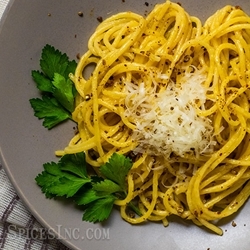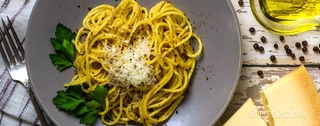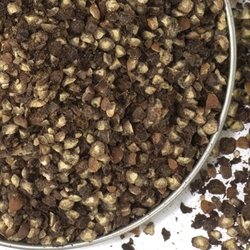Cacio e Pepe

Cacio e Pepe is a classic Italian dish with its origins in the hills surrounding Rome. It is one of the foremost examples of cucina povera, or “poverty cooking”. It’s an approach to food that started in the less affluent regions of Italy—most notably, in the Italian south—that spread throughout the country. Cucina povera centers around using readily available ingredients with as little waste as possible, while creating meals that are satisfying and, somehow, greater than the sum of their parts. Another well-known example of this kitchen philosophy can be seen in the Panzanella Salad, which turns stale bread into a tasty, filling backdrop for fresh, seasonal vegetables and whatever kind of cheese is on hand.
Simplicity and a slow, steady whisking hand are the keys to great Cacio e Pepe. The name of this dish means “cheese and pepper”, and those are all the ingredients you need, along with pasta, a bit of oil, and the hot, salty water in which the pasta is boiled. Choose your ingredients wisely! The small number of ingredients puts extra weight on their quality, since there isn’t anything else to pick up the slack if the cheese is a little off or the pasta is bland and mushy. In order to get stellar results, you should use the best ingredients you can afford. To that end, we decided to use Black Pepper Coarse Grind in our Cacio e Pepe; this peppercorn is allowed to ripen on the vine, and brings complexity and sweetness to the table along with the customary peppery burn that we’ve come to love.
Have everything ready to go when you make Cacio e Pepe. This dish moves along fairly quickly once the pasta is cooked, so start grating cheese and cracking the peppercorns when the water goes on to boil. Make sure your water is salted! Most dried pasta is a blank slate, made from just wheat and water, with perhaps a bit of egg. Cooking it in salted water allows the pasta to absorb salt, seasoning it from the inside and creating a more flavorful product overall. There is one caveat to bear in mind, regarding salt in this dish. Pecorino Romano and Parmigiano Reggiano cheeses tend to be salty on their own, and salt content can vary depending on which brand of cheese you choose. Taste the cheese you’re using before you salt the water and then adjust the water’s seasoning accordingly, to make sure you won’t end up with an over-salted dish.
Once the pasta is cooked, take a ladle and reserve a bit of pasta water from the pot before draining. Our recipe calls for 1/2 a cup of pasta water when you start whisking, but save up to a cup of pasta water in case your dish seems a little dry. Once the pasta is drained, the fun begins. Toast the cracked peppercorns in a dry pan; it shouldn’t take more than a minute for the pepper to release its aroma. Once you start to smell the fragrant, piney, almost floral fragrance of freshly cracked pepper, add the butter and oil to the hot pan. That should melt in under a minute, and once the butter is melted, start whisking in the water. Surely you’re thinking, but oil and water don’t mix. Herein lies the importance of using pasta water. To make this dish, you need to rely on the starch that the pasta has released into the water to create an emulsion that will bind the water and oil. Whisk slowly and steadily, and then start adding the cheese. Again, add slowly and steadily, and whisk in all but about 1/4 of the grated cheese, reserving the last bit for a garnish. Adding the cheese too quickly could cause it to seize and fall in a clump to the bottom of the pan.
After everything’s been whisked into smoothness, pour the drained pasta into the pan and start pulling it through the cheese sauce. This dish is ready when all the pasta has an even coating of sauce. If the sauce starts to clump onto the pasta, loosen it up by adding a few extra sprinkles of pasta water and keep working the pasta through the sauce. It should look glossy and even, covering each strand of spaghetti in a shiny, slick coat. Divide the Cacio e Pepe between two plates and top with remaining cheese and some additional pepper. Serve with a side salad and a crisp glass of white wine and enjoy a classic dish from the Roman countryside.
- 8 ounces dried spaghetti or bucatini
- 1 Tablespoon coarsely ground Black Pepper,Coarse Grind, plus more for garnish
- 1 Tablespoon butter
- 1 Tablespoon extra virgin olive oil
- ½ cup finely grated aged parmesan cheese
- ¼ cup finely grated pecorino romano cheese
- ½ cup reserved pasta water
1. Boil pasta in lightly salted water until it is al dente. Reserve 1 cup of the pasta water and strain the pasta.
2. Over medium heat, add coarsely ground Pondicherry Peppercorns in a dry pan and briefly toast until fragrant. Add butter and olive oil to pepper in the pan and let them heat together. Pour in ½ cup of the pasta water. Start whisking, and then whisk in about 3/4 of the cheese at a slow, steady pace. Add more water if the sauce seems dry or clumpy.
3. Add pasta and toss thoroughly. Garnish with remaining cheese and Pondicherry Peppercorns.


